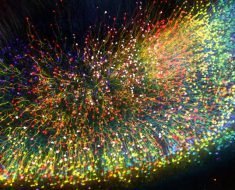A Ph.D. candidate, Ryota Kondo, and Professor Michiteru Kitazaki at Toyohashi University of Technology, and collaborators have found that the visual-motor synchronicity of the hands and feet can induce a sense of illusory ownership over an invisible body interpolated between virtual hands and feet. It can provide the illusory ownership over the invisible body at a distance, or enable the operation of one’s own transparentized body in a virtual environment.
Illusory body ownership can be induced by visual-tactile synchronicity such as the “rubber hand illusion” (a passive method) and by visual-motor synchronicity such as the full-body illusion (an active method). These methods enable people to communicate in cyberspace as well as in real environments. Virtual reality technology enables people to experience the illusory ownership of bodies of different shapes, sizes, genders, ages, etc. The illusory ownership of an invisible body in a first-person perspective has been realized via the passive method, and has been found to reduce social anxiety to an audience (Guterstam, Abdulkarim & Ehrsson, Sci. Rep. 2015).
However, it is not clear whether the ownership of an invisible and dynamic body can be obtained at a distance. The researchers have developed a new method to induce a sense of illusory ownership over an invisible body by focusing on the body action.
They presented only the gloves and socks two meters in front of and away from the participants using a head-mounted display (Figure 1, left). Twenty naïve volunteers answered a questionnaire after a five-minute observation with free body actions. The motion of the gloves and socks were synchronized or asynchronized with the participants’ action. The illusory body ownership was rated higher when the virtual gloves and socks moved synchronously with their own movements than the asynchronous condition. They felt as if their own bodies had become transparent when the motion was synchronized, as compared to when the motion was asynchronized.
The experiments showed that the illusory ownership of the invisible body was not significantly different from the visible whole body (Figure 1, right), and that the proprioceptive self-location drifted toward the invisible body that was at a distance in front of the participants.
Ryota Kondo, a graduate student of the Program of Leading Graduate School at Toyohashi University of Technology said, “I want to create experiences of illusory ownership of various bodies. A person may have a negative feeling with his/her body, and he/she may want to have a different body from his/her current body. Virtual reality technology offers us the opportunities to have the different bodies that we desire.” Professor Michiteru Kitazaki, a perceptual psychologist and the leader of the research at Toyohashi University of Technology explained, “Human behaviors and mind would change when they have the illusory ownership of different bodies. Thus, we must investigate how our communication would differ in the future society if our body ownership and appearance could be significantly modified during the course of our daily lives.”
These findings suggest that we can own a distant invisible body only from our hands and feet. It is useful to show complex body skills to another person and in turn he/she can imitate them for learning because the invisible/transparentized body scarcely occludes the scene, and the body ownership may facilitate skill learning.
Source: Read Full Article





